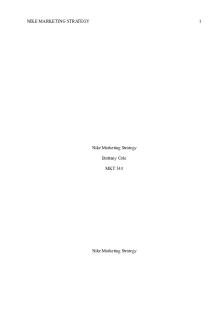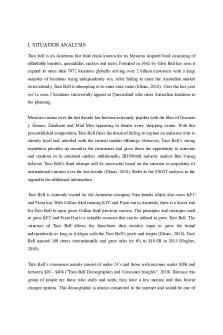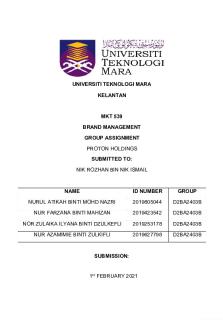Marketing Strategy Plan For Proton Holdings PDF

| Title | Marketing Strategy Plan For Proton Holdings |
|---|---|
| Author | JUN YAN NGU |
| Course | 创业与管理咨 |
| Institution | Xi'an Jiaotong University |
| Pages | 29 |
| File Size | 895.3 KB |
| File Type | |
| Total Downloads | 105 |
| Total Views | 166 |
Summary
Author: Mary Salang;
Course: MARKETING MANAGEMENT
This paper is an assignment, written by an MBA student. Some of the information contained in this paper may be inaccurate and/or outdated. This document can only be used as a point of reference. It is not advisable to use the cont...
Description
MARKETING STRATEGY PLAN FOR PROTON HOLDINGS BERHAD
Written by Mary Salang
MARKETING MANAGEMENT May 16, 2018
Important remarks: This paper is an assignment, written by an MBA student. Some of the information contained in this paper may be inaccurate and/or outdated. This document can only be used as point of reference. It is not advisable to use the content of this paper for any professional purpose.
Table of Contents 1.0 Executive Summary..................................................................................................... 2 2.0 Situation Analysis......................................................................................................... 3 2.1 Company.....................................................................................................................3 2.2 Collaborators.............................................................................................................. 8 2.3 Customers................................................................................................................... 9 2.4 Competitors.............................................................................................................. 10 2.5 Climate..................................................................................................................... 13 3.0 Marketing Strategy.................................................................................................... 14 3.1 Mission..................................................................................................................... 14 3.2 Marketing Objectives............................................................................................... 14 3.3 Financial Objectives................................................................................................. 16 3.4 Target Markets.......................................................................................................... 17 3.5 Positioning................................................................................................................17 3.6 Strategies.................................................................................................................. 19 3.7 Marketing Program...................................................................................................20 3.8 Marketing Research..................................................................................................21 4.0 Financials.................................................................................................................... 22 4.1 Break-Even Analysis................................................................................................ 22 4.2 Sales Forecast........................................................................................................... 23 4.3 Expense Forecast...................................................................................................... 24 5.0 Controls.......................................................................................................................24 5.1 Implementation.........................................................................................................25 5.2 Marketing Organization............................................................................................25 5.3 Contingency Planning.............................................................................................. 25 6.0 Conclusion...................................................................................................................26 References......................................................................................................................... 27
1
1.0 Executive Summary Being the first national badged car company in Malaysia, PROTON Holdings Berhad or widely known as PROTON, is a homegrown automotive brand that is close to the hearts of Malaysians. PROTON was launched in 1983 and its first car, PROTON Saga, became an instant hit. Business was great for a decade until the Asian financial crisis in 1997. Ever since then, PROTON has been in a roller-coaster ride, with declining sales and reducing market share. PROTON’s market share in Malaysia fell from its grace of 74% in 1993 to the lowest of 8.8% in December 2017. At its peak in 2002, PROTON sold 214,373 units, down to just 72,290 in 2016. This is far below its break-even of 100,000 to 120,000 cars per year. By end of March 2016, PROTON reported a net loss of RM1.46 billion. So last year, 2017, DRB-HICOM sold-off 49.9 per cent stake of PROTON to a Chinese automaker, Zhejiang Geely Holdings Group. 2018 moving forward, with the new management in place, can PROTON revive itself and bounce back to success? The objective of this paper is to provide a detail marketing strategy for PROTON, by describing its past, current and future state, with some useful recommendations and analysis that PROTON should consider in their journey to success.
2
2.0 Situation Analysis Lets look at PROTON’s situation analysis using The 5 C’s: Company, Collaborators, Customers, Competitors and Climate.
2.1 Company The conceptual idea of National Car was originated in 1979 by Tun Dr Mahathir Mohamad, the 4th Prime Minister of Malaysia at that time. PROTON Holdings Berhad, (PHB; informally PROTON) was incorporated in 7 May 1983. It is a Malaysia-based corporation, active in automobile design, manufacturing, distribution and sales. 'PROTON' stands for Perusahaan Otomobil Nasional in Bahasa Malaysia (translated as National Automobile Company). PROTON’s headquarter is in Shah Alam, Selangor and it operates additional facilities at PROTON City, Perak (Tanjung Malim). PROTON is currently undergoing a transformation process as part of a long-term turnaround plan. PROTON's tie up with Geely is expected to return the company into profitability and regaining an international presence, betting on the introduction of the much-anticipated SUV named Boyue planned to be launched by the end of 2018. Below is PROTON’s marketing mix based on Kotler’s 4Ps model: Product, Price, Place and Promotion.
3
Product Offering PROTON has several product variance to meet different needs and tastes of customers.
PROTON’s 8 current models line up with calender year of introduction
PROTON’s current models are as follows:1) PROTON Saga (1985–present; A-Segment sedan) : Price RM36,800 2) PROTON Persona (2007–present; B-Segment sedan) : Price RM46,350 3) PROTON Iriz (2014–present; B-Segment hatchback) : Price RM41,620 4) PROTON Ertiga (2016–present; B-Segment mini-MPV) : Price RM58,800 5) PROTON Preve (2012–present; C-Segment sedan) : Price RM58,710 6) PROTON Suprima S (2013–present; C-Segment hatchback) : Price RM69,840 7) PROTON Exora (2009–present; C-Segment MPV) : Price RM67,220 8) PROTON Perdana (1995–present; D-Segment sedan) : Price RM113,438
PROTON’s former car model are as follows:9) PROTON Arena (2002-2010; C-segment coupe utility) 10) PROTON GEN•2 (2004-2012; C-segment hatchback) 11) PROTON Inspira (2010-2015; C-segment sedan) 12) PROTON Juara (2001-2003; A-segment microvan/MPV) 13) PROTON Putra (1996-2001; C-segment coupe) 14) PROTON Satria (1994-2005; C-segment hatchback) 15) PROTON Satria Neo (2006-2015; B-segment hatchback) 16) PROTON Savvy (2005-2011; A-segment hatchback) 17) PROTON Tiara (1996-2000; A-segment hatchback) 4
18) PROTON Waja (2000-2011; C-segment sedan) 19) PROTON Wira (1993-2009; C-segment sedan)
Critical Issues Throughout 35 years of business, PROTON has a long list of issues. Made wrong investment at the wrong time - After its incorporation in 1983, PROTON’s sales grew steadily and the future looked very promising. PROTON was very ambitious that it bought Lotus Cars in 1996 to leverage on Lotus’ solid engineering capabilities that PROTON could not have developed on its own. Sadly, the investment was not a good move because of the financial crisis. Since 1996, Lotus Cars have lost money amounting to an estimated of RM6 billion for over 20 years.
Too volatile for competition - In 2005, PROTON was overtaken by the second car manufacturer in Malaysia, named The Perusahaan Otomobil Kedua Sendirian Berhad (widely known as Perodua). PROTON’s sales declined for five years in a row due to cheaper and more competitive offerings from Perodua. And then, in 2016, PROTON was overtaken by Honda, putting PROTON in the third place, with Perodua at 32% , followed by Honda at 18% and PROTON at 15%.
Protectionism policy by the government - A total of RM15.3 billion financial assistance in the form of soft loans and grants was provided to national automaker Proton Holding's Bhd since 1984.
Failing exports business - PROTON started exporting cars into the UK in 1989 and Australia 1995. Exports sales to UK and Singapore have dropped to zero. In Australia, from January to April 2017, PROTON only managed to sell 11 cars.
Huge financial losses - PROTON reported a net loss of RM1.46 billion in FY2016 ended March 31. In the bid to save PROTON’s financial situation, DRB-HICOM took over PROTON in 2012. DRB-HICOM itself incurred net losses of RM991.90 million in the
5
financial year ended March 31, 2016, mainly due to the poor performance of PROTON.
Jobs insecurity for its employees - Geely is now leading the production, sales and marketing and Geely planned to relocate PROTON’s production plant from Shah Alam to Tanjung Malaim, Perak making the future for PROTON’s 12,000 employees uncertain. Underutilized production - PROTON is only producing around 70,000 units in 2016, whereas its Tanjung Malim plant is able to produce an average of 500,000 cars annually. Poor product quality - Based on a research on “Malaysians Perception on PROTON Cars”, a report by Assoc. Prof. Dr. Idris bin Md.Noor from Universiti Malaysia Perlis, in general, Malaysians have negative public perceptions about PROTON cars mainly because of its poor product quality compared to other competitive brands. Poor service quality - According to J.D. Power 2017 Malaysia Customer Service Index (CSI), PROTON ranked number 9 (out of 10) with CSI rated average below average, mainly due to a poor service quality.
Keys to Success As we will discover more in this document, PROTON’s keys to success is to improve its product and service quality, reduce costs, find new market through international exports, increase utilization rate of its plants and last but not least, focus on people development.
6
SWOT Analysis
PROTON’s SWOT Analysis
Strengths : PROTON is the first national car manufacturer in Malaysia and it has 34 year-old legacy. This gives the company a good base and loyal customers. With variety of car models, PROTON is able to meet different needs of its target segments. PROTON’s cars are affordable and consumers buy PROTON because of its value for money.
Weaknesses : PROTON’s poor product and service quality is giving it a negative public perception. PROTON lacks expertise in advanced automotive engineering technology, which is why it has to collaborate with international partners who are experts in this area. PROTON has high costs due to costly parts and costly technologies.
Opportunities : By increasing the utilization of its Tanjung Malim plant in Perak, PROTON would be able to produce an average of 500,000 cars annually. PROTON can leverage on its collaboration with Geely, and have access to Geely’s research and development (R&D) center, which is equipped with Swedish technology and 10,000 engineers from 46 countries. Partnership with Geely will also expose PROTON to global expansion with the opportunity to tap into 1.4 billion new market segment in China.
7
PROTON has always been receiving support from the government, for example, in 2017, the Malaysian government has allocated RM200 million for the relocation of PROTON Holdings Bhd’s development plant from Shah Alam, Selangor, to Tanjung Malim in Perak.
Threats : PROTON lost its market share from 70% before to below 15% because of competitors. Main competitor of PROTON is PERODUA. Fuel price increase will put-off customers into buying cars in general, which may impact PROTON as carmaker company. PROTON is also threatened by market maturity in Malaysia, therefore it makes more sense for PROTON to export its cars outside of Malaysia. According to Malaysia Automotive Institute (MAI), the automotive industry will experience a slow market growth at 2%. Car performance technology is changing fast and PROTON is not quick enough to catch up to the changes.
2.2 Collaborators PROTON’s former partners were Mitsubishi, Citroën and Youngman. PROTON’s current partners are Honda, Suzuki and Geely. PROTON also work with its authorized dealers.
Honda On 29 October 2012, PROTON entered a collaboration with Honda Motor Company, Ltd. The result of the collaboration, the second generation PROTON Perdana to replace the ageing PROTON Perdana V6, was unveiled on 11 December 2013 at an official ceremony in Putrajaya.
Suzuki PROTON partnered with Suzuki and rebadged the Suzuki Ertiga.
Geely Holdings PROTON can benefit from Geely’s expertise on advanced automotive technology, in return, Geely will help to increase the utilization rate of PROTON’s production plant in
8
Tanjung Malim by using it as the main hub to produce its right-hand cars. The partnership will see the launching of the much-awaited SUV named Boyue by end of 2018. Looking forward, the company is set to introduce more models to be co-developed with Geely.
Authorized Dealers As part of PROTON’s business expansion plan, the national automaker is targeting to convert all of its 1S (only sales) authorized dealers to 3S (sales, service and spare parts) or 4S (the fourth ‘S’ includes body and paint) service centers. The target is to increase the centers to a total of 109. Up until now, PROTON only has 66 authorized service centers.
2.3 Customers Market segmentation Behavioral factors If we look at PROTON’s wide range of product offerings, it is clear that PROTON targets customers with different behavioral factors, based on customers’ different background, status and lifestyles who sought different benefits and occasions when buying a PROTON. For example, PROTON’s 7-seater MPV called PROTON Exora targets a big family who travel together most of the time. Hence, features such as safety and comfort is essential for this group of target market. On the other hand, PROTON Suprima targets young, active and single men with its athletic personality and sportier hatchback feature.
Demographic factors PROTON targets customers aged 20 years and above, male and female, all races, family member of 3 to 5, working adults with average monthly income of RM2,500 and above.
Psycho-graphic factors Being labeled as a national car, PROTON harps on patriotism to influence the buying decisions of its customers. It gives them a sense of belonging.
9
Market Needs There are five types of needs. Based on the picture below, PROTON may not have yet captured the secret needs of customers.
2.4 Competitors Last year, PROTON ranked at number 3 in terms of number of units of car sold and market share. The gap between PROTON and Toyota is very little, so if PROTON is not careful, Toyota could overtake it in 2018.
No
Brand
Units sold in 2017
Market share (%) in 2017
1
PERODUA
204,887
35.5
2
HONDA
109,511
19.0
3
PROTON
70,991
12.3
4
TOYOTA
70,445
12.2
5
NISSAN
27,154
4.7
Source: Malaysia Automotive Institute (MAI)
PERODUA Malaysia's second largest automobile manufacturer after PROTON, Perusahaan Otomobil Kedua Sendirian Berhad (Perodua), was established in 1992. Perodua operates two
10
manufacturing plants in Malaysia, with a maximum annual capacity of 350,000 units. Perodua exports to Indonesia, Singapore, Mauritius, Fiji, Sri Lanka and Brunei. Perodua is leading the market share with 35.5% in 2017. Perodua sold 204,887 unit in 2017 and target to sell 209,000 units in 2018.
HONDA Honda Malaysia Sdn. Bhd. was incorporated in 2000 and is based in Alor Gajah, Malaysia. Honda has 96 dealerships nationwide. Honda retains its leading position as the top non-national car brand in Malaysia and second place in overall total industry volume. Honda Malaysia captured 19% of the market share in 2017 and this year 2018, it targets to sell 109,000 units to capture 18% market share.
TOYOTA UMW Toyota Motor Sdn. Bhd. (UMWT) distribute, assemble and export Toyota vehicles in Malaysia. In 2017, Toyota managed to sell 70,445 units and target to sell more than 70,000 units in 2018. Below is Porter’s Five Forces Framework for PROTON, to understand its business environment better.
11
Porter’s Five Forces for PROTON
Industry Rivalry - As mentioned before, PROTON’s main competitors are Perodua, Honda and Toyota. Threat of Substitutes - Customers can use public transportation and other means of transportation to substitute with PROTON. Threat of New Entrants - Automotive industry is highly regulated with high costs, hence the entry barrier is very high. Bargaining power of Buyers - Car buyers have high bargaining powers because they have many choices in the market (similar product with similar price range) and substitutes. Bargaining power of Suppliers - Local spare parts suppliers used to be powerful with PROTON last time, but now with Geely’s partnership, PROTON has an alternative option to source cheaper spare parts from China.
12
2.5 Climate Market maturity The automotive market in Malaysia is facing market maturity. Compared to neighboring country such as Thailand, Malaysia is a more mature market for automotive industry. According to a report by MAI, Malaysia’s vehicle to 1,000 people ratio is 348.6 , which is higher than Thailand 228.1 and Indonesia 87.3.
Market Trends Based on an automotive updates by Malaysia Automotive Institute (MAI), the global automotive future trends are going towards electric vehicle, plug-in hybrids and green cars. There is also an interest in intelligent mobility. Perhaps this is one area that PROTON could look at in future in order to meet the market trends. Market Growth The last couple of years have not been that great for players in the automotive industry. Automotive Association (MAA) reported that the total industry volume (TIV) of newly registered vehicles declined marginally by 0.6% in 2017. For 2018, both MAA and The International Trade and Industry Ministry projected a 2% growth. MAI report also mentioned that Malaysia’s TIV is comparatively lower than other Asean countries. TIV in Thailand is more than 1.9 million units and Indonesia is more than 1.2 million units. Hence, exports is the way moving forward.
13
3.0 Marketing Strategy Strategically, PROTON aimed to transform the business into profitability, hence the decision to partner with Geely. PROTON is also looking at the opportunity to expand into South East Asia markets. PROTON believe its value proposition of offering quality cars at lower price will capture the market successfully.
To support the strategic decision, PROTON will implement key tactical plan. PROTON’s cars will be equipped with advanced automotive technology from China, combined with Volvo’s durability features for safety and comfort. Product price will be kept lower than its competitors who offer similar range of product. Sales and service channels through authorized dealers are upgraded from 1S to 3S/4S. Mark...
Similar Free PDFs

marketing plan strategy
- 13 Pages

Marketing Strategy FOR Ducati
- 11 Pages

Marketing Plan for Amabrush
- 10 Pages

Marketing Strategy
- 5 Pages

marketing strategy
- 5 Pages

Proton&Perodua - Proton and Perodua
- 20 Pages

Marketing Plan for Snap. Inc.
- 16 Pages

Marketing plan for taco bell
- 14 Pages

Marketing plan for a gym
- 12 Pages

Marketing plan for Marks & Spencer
- 11 Pages

Marketing plan for coconut juice
- 15 Pages
Popular Institutions
- Tinajero National High School - Annex
- Politeknik Caltex Riau
- Yokohama City University
- SGT University
- University of Al-Qadisiyah
- Divine Word College of Vigan
- Techniek College Rotterdam
- Universidade de Santiago
- Universiti Teknologi MARA Cawangan Johor Kampus Pasir Gudang
- Poltekkes Kemenkes Yogyakarta
- Baguio City National High School
- Colegio san marcos
- preparatoria uno
- Centro de Bachillerato Tecnológico Industrial y de Servicios No. 107
- Dalian Maritime University
- Quang Trung Secondary School
- Colegio Tecnológico en Informática
- Corporación Regional de Educación Superior
- Grupo CEDVA
- Dar Al Uloom University
- Centro de Estudios Preuniversitarios de la Universidad Nacional de Ingeniería
- 上智大学
- Aakash International School, Nuna Majara
- San Felipe Neri Catholic School
- Kang Chiao International School - New Taipei City
- Misamis Occidental National High School
- Institución Educativa Escuela Normal Juan Ladrilleros
- Kolehiyo ng Pantukan
- Batanes State College
- Instituto Continental
- Sekolah Menengah Kejuruan Kesehatan Kaltara (Tarakan)
- Colegio de La Inmaculada Concepcion - Cebu




